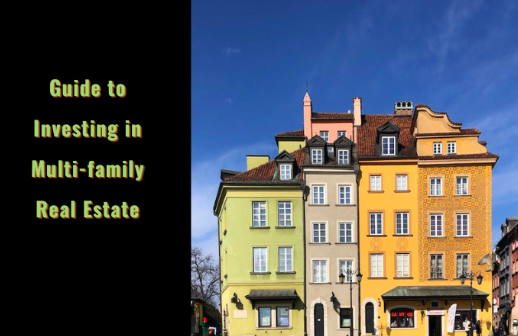Real estate has the greatest potential of all assets for capital gains and wealth accumulation. While certain risks are associated with real estate – no private asset is completely secure – they can be mitigated greatly by strategic investments and smart planning. This is where investing in multifamily real estate comes into the picture.
What is Multifamily Real Estate Investing?
Multifamily properties have gained prominence as a relatively safe investment area, especially in the United States, where people have been wary of investing in stocks and bonds due to frequent fluctuations and fear of a recession.
Multifamily housing investment refers to buying multi-family properties – residential complexes with more than one housing unit, such as apartment complexes, condominiums, duplexes, triplexes, etc. – which can be leased out to earn rent. The cost of each property varies depending on the size of the building, location, depreciation, the size of the individual units in the complex, and many other factors.
Nonetheless, most people find it convenient to rent an apartment in a multifamily property rather than purchasing a single-family unit due to the affordability and availability of several amenities around the property. From an investor’s point of view, these properties are highly efficient in terms of land usage and infrastructure creation. Hence, investing in multi-family homes is a cost-efficient and profit-maximizing venture for tenants and investors, respectively.
How is it Different from Single-family Real Estate?
As the name suggests, single-family real estate is a property with space for only one family. Bungalows, townhouses, and fully-detached or semi-detached houses are popular examples of such properties. Before making an investment decision, some significant differences between multifamily and single-family homes should be considered.
- Occupancy: The people who invest in multi-family properties do not occupy the units in most cases. They can keep one or two units to themselves while others are rented out to generate a healthy passive income. Single-family property investors usually go for the “own and occupy” option.
- Mortgage: Multifamily investors can easily offset the mortgage costs with the constant flow of income (rent from the leased out units), whereas single-family investors have to look for alternatives to pay the mortgage. This is usually sourced from active income.
- Maintenance and repair: Multifamily homes have large-scale supporting systems and utilities like plumbing, air conditioning, and heating. While it may appear that they are difficult to maintain, they are actually very cost-effective in terms of area and labor. Moreover, there is a scope to add eco-friendly options at affordable prices, and the demand for “green homes” is a good incentive for investing in multifamily real estate. On the other hand, single-family units have small-scale systems which are easy to maintain, but the cost per unit and labor is relatively high. Installation of eco-friendly elements such as solar panels is expensive.
What Should You Keep in Mind When Investing in Multi-Family Homes?
You should keep some important determining factors in your mind before you invest in multi-family properties. These factors can help you understand how profitable your venture will be.
- Location of the Property: The value of any property depends on where it is located. A multifamily real estate situated around schools, universities, commercial offices, or multinational companies has a higher value than properties located on the city’s outskirts with few amenities available.
- Down Payment: Multifamily properties have a higher down payment for loans than single-family units. As the number of units in a multifamily complex increases, so does the amount of down payment. You should make your budget around a minimum 25% down payment. However, if you are eligible for an FHA loan, you can invest in multi-family properties of up to 4 units with a 3.5% down payment.
- Net Operating Income: NOI is your property’s gross income adjusted for operating expenses. It is calculated on an annual basis. NOI depends on how well you finance your assets and how much you spend on its operation and maintenance. Higher NOI means more disposable income.
- Debt-to-Income Ratio: This ratio is used to analyze how much of your income from the real estate will be adequate to cover mortgage payments. It is calculated by dividing the yearly NOI by the outstanding debt (including both principle and interest.)
- Capitalization Rate: Also known as the Cap Rate, it is derived by dividing the NOI of the property you are interested in with its current property asset rate. In simple terms, it is the rate of return you expect to earn on your multifamily apartment investment. It is useful for making comparisons between different real estates.
How is Multifamily Housing Investment Advantageous?
There are numerous benefits to multifamily real estate investment. Four most important advantages are:
- Passive Income and Cash Flows: When you make a multifamily apartment investment, you bring numerous housing units under one comprehemsive mortgage plan and an insurance policy. Thus, it becomes easy to manage these properties, and with enough economies of scale, you can also hire a professional manager. As a result, you have an influx of cash and a sizeable passive income from rent with a high amount left at your disposal.
- Diversifying Portfolio: The secret to success in the real estate industry is diversifying your real estate investment portfolio. When you buy a multifamily property, your return on investment (ROI) may be significantly higher than what you might anticipate from other investment strategies. .
- Lower Risks and More Returns: Even when the economy crashes down, people will demand housing because it is a basic human requirement. Therefore, multifamily real estate is a relatively “secure” investment with fewer risks of foreclosures, mismanagement, and tax errors.
- Scalability: The logic here is simple – you invest in a property initially, you earn a high passive income, pay off your mortgage, and reinvest the surplus in more such properties. The economies of scale allow for scalability opportunities in real estate.
This guide is meant to educate you on the basics of multifamily housing investment and how to invest in multi-family properties. This real estate is a lucrative business with immense growth opportunities and potential of giving you a comfortable life after retirement. You can be sure that you will have a steady source of income even during a recession.
Learn more about investing in multi-family homes with The Multifamily Mindset and find ways to start increasing your wealth!


















